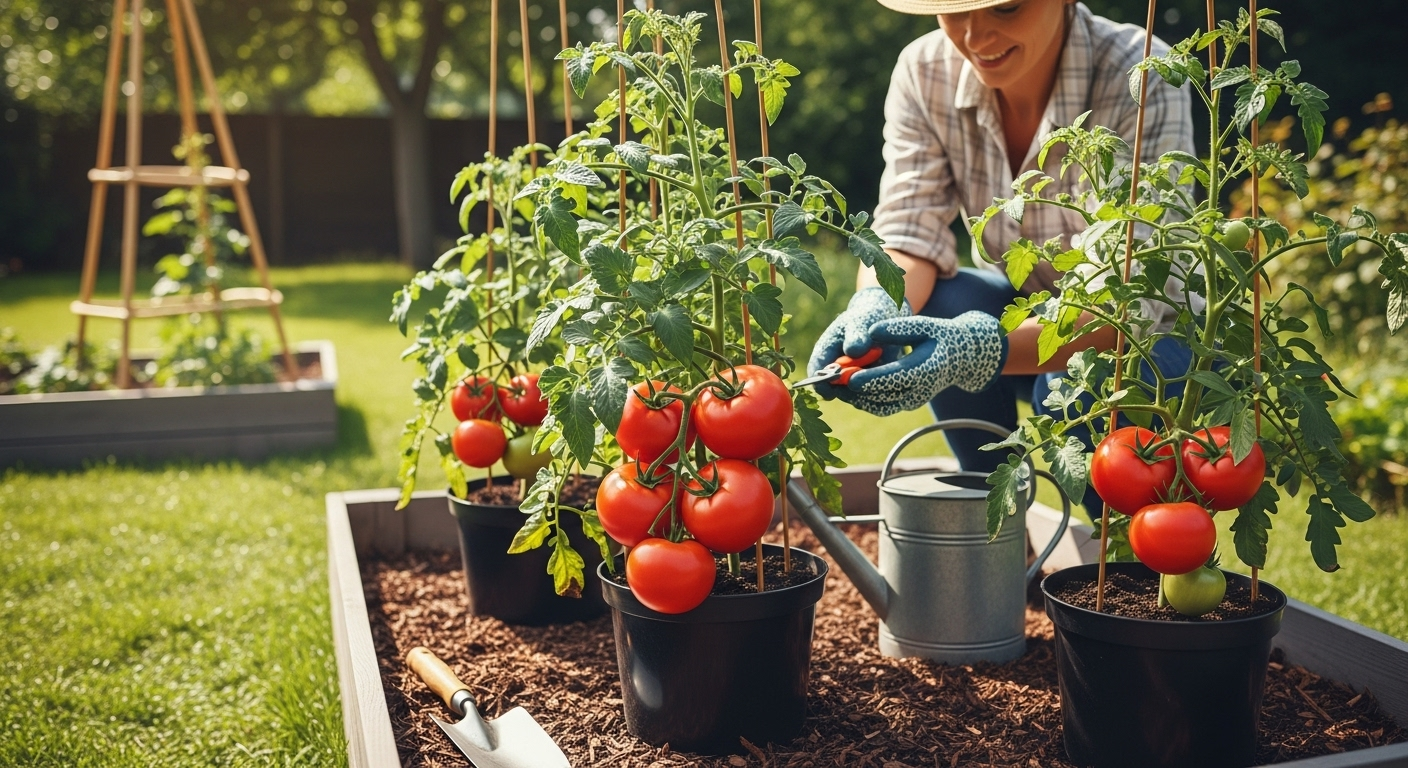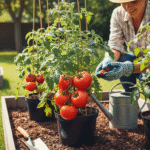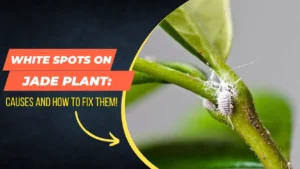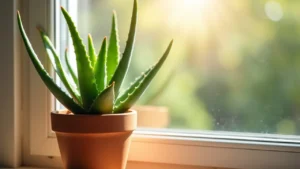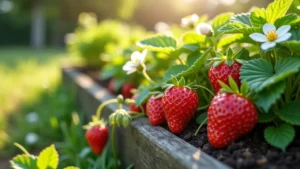Few gardening experiences are as satisfying as picking your own sun-ripened, juicy tomatoes straight from the vine. Whether you grow them in containers on a balcony or in a spacious backyard, tomato plants reward your care with vibrant color, rich flavor, and endless culinary possibilities.
Tomatoes are a favorite among home gardeners worldwide because they’re versatile, relatively easy to grow, and adapt beautifully to different climates. From crisp salads and hearty sauces to tangy chutneys and roasted dishes — the humble tomato is the heart of every kitchen garden.
If you’ve ever dreamed of growing your own tomatoes but weren’t sure where to start, this guide — drawn from years of real-world gardening experience — will teach you exactly how to care for a tomato plant for a bountiful, healthy harvest.
Table of Contents
🍅 Tomato Plant Overview
Tomato plants (Solanum lycopersicum) belong to the nightshade family (Solanaceae), which also includes peppers, potatoes, and eggplants. These warm-season plants are native to South America but have become a staple crop across the globe.
Tomatoes come in many varieties — each with its own charm and purpose:
- Cherry tomatoes: Small, sweet, and perfect for salads or snacking.
- Beefsteak tomatoes: Large, meaty, and ideal for sandwiches or burgers.
- Roma (plum) tomatoes: Thick-fleshed, excellent for sauces and pastes.
- Heirloom tomatoes: Unique colors and flavors, prized by gourmet gardeners.
Nutritionally, tomatoes are packed with vitamin C, potassium, folate, and lycopene, an antioxidant linked to heart health and cancer prevention.
Best of all, they can be grown in garden beds, containers, or greenhouses, making them accessible to everyone — from city dwellers to country gardeners.
🌱 Tomato Plant Quick Care – Table
| Feature | Details |
|---|---|
| Scientific Name | Solanum lycopersicum |
| Common Name | Tomato Plant |
| Native Region | South America |
| Light Requirements | Full Sun (6–8 hours daily) |
| Watering Needs | Regular, deep watering (keep soil evenly moist) |
| Propagation | Seeds or stem cuttings |
| Toxicity | Leaves and stems mildly toxic to pets if ingested |
| Growth Rate | Fast-growing annual |
| Ideal Temperature | 20–30°C (68–86°F) |
🌾 Tomato Plant Requirements – Table
| Feature | Details |
|---|---|
| Hardiness | Tender annual |
| Climate Zones | USDA Zones 10–11 (grown as annual elsewhere) |
| Plant Type | Fruiting vegetable |
| Plant Family | Solanaceae |
| Plant Genus | Solanum |
| Season of Interest | Spring to early fall |
| Height | 2–6 feet (depending on variety) |
| Spread | 18–36 inches |
| Spacing | 18–24 inches apart |
| Depth | Plant deeper than seedling pot (bury two-thirds of stem) |
| Maintenance | Moderate |
| Soil Type | Loamy, nutrient-rich |
| Soil pH | Slightly acidic (6.0–6.8) |
| Soil Drainage | Well-drained but moisture-retentive |
🌞 How to Care for a Tomato Plant
Below is a complete, experience-backed guide to growing strong, healthy, and high-yielding tomato plants.
☀️ Tomato Plant Light Requirements
Tomatoes are sun-loving plants that thrive with at least 6–8 hours of direct sunlight daily. Insufficient light leads to leggy stems, poor flowering, and low fruit yield.
If you’re growing tomatoes indoors, position them near a bright south-facing window or use grow lights to supplement light exposure.
🌿 Pro Gardener Tip: Rotate your tomato pots every few days to ensure even sunlight on all sides — this prevents uneven growth.
💧 Tomato Plant Watering
Tomatoes need consistent moisture to develop juicy fruits. Water deeply 2–3 times a week, depending on your climate and soil type. Avoid shallow watering, which encourages weak roots.
- Keep soil evenly moist, not soggy.
- Water early in the morning to allow foliage to dry and prevent diseases.
- Use mulch (straw or compost) around the base to retain moisture and reduce evaporation.
🌿 Pro Gardener Tip: Insert your finger into the soil — if the top inch feels dry, it’s time to water. Overwatering can lead to root rot and blossom-end rot.
🌱 Tomato Plant Soil
Tomatoes thrive in loamy, well-draining, and nutrient-rich soil. Ideal pH ranges from 6.0 to 6.8.
Before planting, enrich your soil with organic compost, aged manure, or worm castings to boost fertility and microbial activity.
🌿 Pro Gardener Tip: Avoid planting tomatoes in the same soil where peppers, eggplants, or potatoes were grown the previous year — this helps prevent soil-borne diseases like verticillium and fusarium wilt.
Best Pot or Garden Bed for Tomato Plant
If space is limited, tomatoes grow beautifully in containers or grow bags. Choose:
- Pot size: Minimum 12–18 inches deep
- Material: Terracotta, plastic, or fabric grow bags
- Drainage: Ensure multiple holes for water flow
Use a high-quality potting mix containing compost, cocopeat, and perlite.
🌿 Pro Gardener Tip: Stake or cage your tomato plant early — it supports growth, prevents fruit rot, and improves air circulation.
🌿 Repotting Tomato Plant (if container-grown)
Container-grown tomato plants may need repotting once they outgrow their pots. Signs include visible roots or stunted growth.
- Gently remove the plant from its current container.
- Place it in a larger pot filled with fresh, enriched soil.
- Bury the plant deeper, up to the first set of true leaves — new roots will form along the buried stem, strengthening the plant.
🌿 Pro Gardener Tip: Always repot in the evening or on a cloudy day to reduce transplant shock.
🌡️ Tomato Plant Temperature
Tomatoes prefer warm temperatures between 20–30°C (68–86°F). Avoid cold drafts or temperatures below 10°C, as they can slow growth or kill the plant.
If you live in a cooler region, use row covers or mini greenhouses to extend the growing season.
🌿 Pro Gardener Tip: Tomatoes dislike sudden temperature swings — try to keep day and night temperature differences minimal for consistent fruiting.
💨 Tomato Plant Humidity Requirement
Moderate humidity levels (40–70%) are ideal.
High humidity can lead to fungal diseases, while very dry air can cause flower drop.
🌿 Pro Gardener Tip: Provide good airflow by spacing plants properly and avoiding overhead watering — it keeps leaves dry and healthy.
✂️ Tomato Plant Pruning
Regular pruning encourages airflow, prevents disease, and directs energy toward fruit production.
- Remove suckers (small shoots growing between main stem and leaf joints).
- Cut off yellow or lower leaves touching the soil.
- For indeterminate (vining) varieties, prune lightly but regularly.
🌿 Pro Gardener Tip: Use clean, sharp shears — and never prune wet plants to avoid spreading fungal infections.
🌼 Tomato Plant Fertilizer
Tomatoes are heavy feeders. Feed them regularly for robust growth and maximum yield.
- Before planting: Mix compost or slow-release organic fertilizer into the soil.
- During growth: Use a balanced fertilizer (10-10-10) every 2–3 weeks.
- At flowering stage: Switch to phosphorus and potassium-rich fertilizer (like 5-10-10) to boost flowering and fruiting.
🌿 Pro Gardener Tip: Avoid excess nitrogen — it leads to lush foliage but poor fruit production.
🐛 Tomato Plant Pests and Diseases
Tomatoes can attract several pests and diseases, but with vigilance and preventive care, you can keep them healthy.
Common Pests:
- Aphids
- Whiteflies
- Tomato hornworms
- Spider mites
Common Diseases:
- Early blight
- Powdery mildew
- Fusarium wilt
- Blossom-end rot
Control Measures:
- Spray neem oil or insecticidal soap weekly.
- Remove infected leaves immediately.
- Rotate crops each season.
- Keep the garden clean and weed-free.
🌿 Pro Gardener Tip: Companion planting with basil or marigold helps repel pests naturally and improves tomato flavor!
🌻 Conclusion
Growing tomato plants is one of the most rewarding gardening adventures. With the right balance of sunlight, water, nutrients, and care, your tomato plants will reward you with baskets of fresh, flavorful fruit all season long.
Remember the golden rules:
- Keep the soil rich and moist but not soggy.
- Feed regularly and prune wisely.
- Watch for pests early and maintain consistent sunlight.
Whether you’re a first-time grower or a seasoned gardener, learning how to care for a tomato plant connects you to the simple joy of growing your own food — bringing color, health, and flavor straight from the garden to your plate.
🌿 Happy Gardening — and may your tomatoes always be red, ripe, and delicious!

